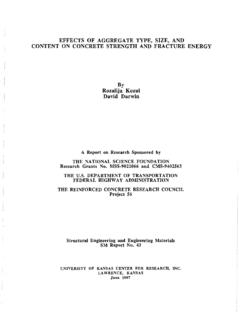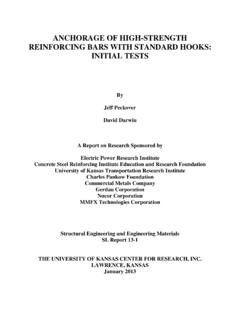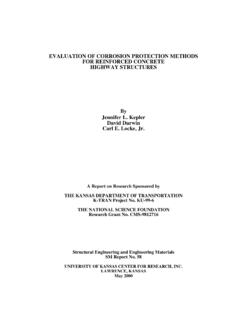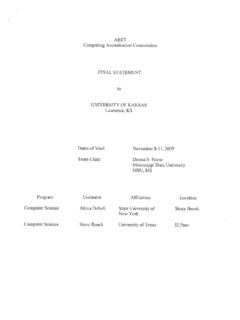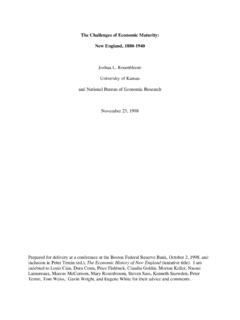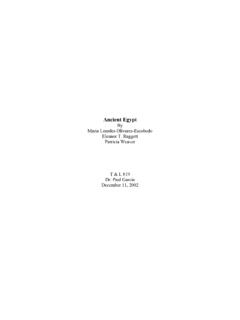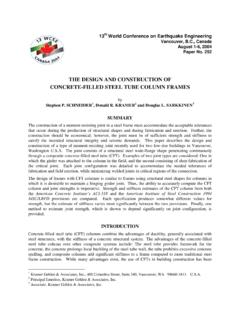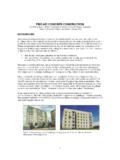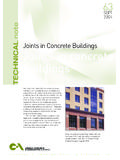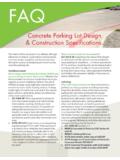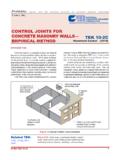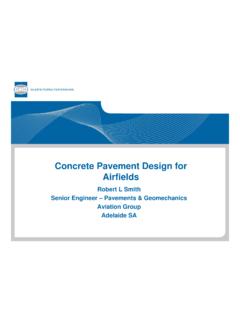Transcription of JOINT DESIGN FOR REINFORCED CONCRETE …
1 JOINT DESIGN FOR REINFORCED CONCRETE BUILDINGS By Michael J. Pfeiffer David Darwin A Report on Research Sponsored by THE UNIVERSITY OF KANSAS STRUCTURAL ENGINEERING AND MATERIALS LABORATORY Structural Engineering and Engineering Materials SM Report No. 20 December 1987 THE UNIVERSITY OF KANSAS CENTER FOR RESEARCH, INC. 2291 Irving Hili Drive, Lawrence, Kansas 66045 JOINT DESIGN FOR REINFORCED CONCRETE BUILDINGS by Michael J. Pfeiffer David Darwin A Report on Research Sponsored by The University of Kansas Structural Engineering and Materials Laboratory UNIVERSITY OF KANSAS LAWRENCE, KANSAS December 1987 ii Abstract JOINT DESIGN FOR REINFORCED CONCRETE BUILDINGS This report discusses construction , contraction and expansion joints in REINFORCED CONCRETE buildings.
2 The report addresses the purpose of each type of JOINT and emphasizes the selection of JOINT locations and JOINT spacings. Some aspects of JOINT configuration and construction are also covered. Empirical and analytical DESIGN techniques are presented. \ iii Acknowledgements This report is based on a project report submitted by Michael J. Pfeiffer to the Civil Engineering Department of the University of Kansas in partial fulfillment of the requirements for the MSCE degree. Support for publication of the report is provided by the University of Kansas Structural Engineering and Materials Laboratory and the Department of Civil Engineering. , \ iv Table of Contents ABSTRACT ACKNOWLEDGEMENTS LIST OF TABLES LIST OF FIGURES.
3 INTRODUCTION THE NEED FOR JOINTS. construction JOINTS. JOINT construction . JOINT Location. Summary CONTRACTION JOINTS JOINT Configuration JOINT Location. EXPANSION JOINTS Single Story Buildings: Martin and Acosta Single and Multi-Story Buildings: Varyani and Radhaji Page ii iii v vi 2 4 5 6 9 9 10 10 11 13 18 Single and Multi-Story Buildings: National Academy of Sciences 24 REFERENCES. 30 TABLES. 33 FIGURES 45 APPENDIX A -NOTATION 53 APPENDIX B -EXPANSION JOINT EXAMPLES 55 Example 1: Single Story-Multi Bay building . 55 Example 2: Multi Story-Multi Bay building . 65 , \ Figure 2 3 4 vi LIST OF FIGURES Page Wall expansion JOINT cover (courtesy Archi tectural Art Mfg Inc.)
4 45 Fire rated filled expansion JOINT (courtesy Architectural Art Mfg., Inc.) o 0 0 0 45 Length between expansion joints vs. DESIGN change, aT (Martin & Acosta 1970) temperature (1 ft = m.; ,.F = ~OC) Multi-bay frame and one bay substitute frame (after Varyani & Radhaji 1978) " " 0 " 46 .. " " " " " 47 5 Moments at base of corner columns due to gravity 6 one bay substitute frames (after Varyani & Radhaji 1978) 48 Moments at base of corner columns due to temperature change using one bay substitute frames L. = total length between expansion joints (after Varyani & Radhaji 1978) 49 7 Expansion JOINT criteria of the Federal construction Council (National Academy of Sciences 1974) (1 ft = m; 1 F = ~OC).
5 50 8 Expansion JOINT criteria of one federal agency (National Academy of Sciences 1974) (1 ft = m; 1 F = ;OC).. 51 9 Frames subjected to a uniform temperature change (National Academy of Sciences 1974) 52 INTRODUCTION Volume changes caused by changes in moisture and temperature should be accounted for in the DESIGN of REINFORCED CONCRETE buildings. The magnitude of the forces developed and the amount of movement caused by these volume changes is directly related to building length. Contraction and expansion joints limit the magnitude of forces and movements and cracking induced by moisture or temperature change by dividing buildings into individual segments.
6 Joints can be planes of weakness to control the location of cracks (contraction joints), or lines of total separation between segments (expansion joints). There is currently no universally accepted DESIGN approach to accom-modate building movements caused by temperature or moisture changes. Many designers use "rules of thumb" that set limits on the maximum length between building joints. Although widely used, rules of thumb have the drawback that they do not account for the many variables which control volume changes in REINFORCED CONCRETE buildings. For example, variables which affect the amount of ther-mally induced movement include the percentage of reinforcement, which limits the amount of movement and cracking in the CONCRETE ; the restraint provided at the foundation, which limits the movement of the lower stories; the geometry of the structure, which can cause stress concentrations to develop, especially at abrupt changes in plan or elevation; and provisions for in-sulation, cooling, and heating, which affect the ability of a building to dampen the severity of outside temperature changes.
7 In addition to these variables. the amount of movement in a building is directly related to the type of aggregate, cement, mix proportions, admix-tures, humidity, construction sequence. and curing procedures used. While 2 these variables can be addressed quantitatively, their consideration is usually beyond the scope of a typical DESIGN sequence and will not be con-sidered here. A number of these parameters are addressed by Mann (1970). The purpose of this report is to provide guidance for the placement of contraction and expansion jOints in REINFORCED CONCRETE buildings. A sec-tion is included on construction joints. Isolation joints on slabs on grade within the buildings are not covered.
8 The following section provides a brief overview, outlining the need for joints. The next section is devoted to construction jOints, reviewing cUr-rent procedures for locating and detailing these joints. A section on contraction joints follows, reviewing current recommendations for contrac-tion JOINT spacing. In the final section, three different approaches to expansion JOINT placement are presented: Martin and Acosta (1970), Varyani and Radhaji (1978), and the National Academy of Sciences (1974). DESIGN ex-amples illustrate the application of the three methods. For additional information, the reader is directed to an annotated bibliography by Gray and Darwin (1984).
9 THE NEED FOR JOINTS Due to the low tensile capacity of CONCRETE , some cracking in rein-forced CONCRETE is unavoidable. Contraction joints provide a weakened plane for cracks to form. Through the use of architectural details, these jOints can be located so that cracks will occur in less conspicious locations within a building and possibly be eliminated from view. Expansion joints allow thermally induced movements to occur with a min-imum build-up of stress. The greater the spacing between jOints, the greater the stresses. TypicallY, these jOints isolate a frame into a series I , 3 of segments with enough JOINT width to allow the building to expand with in-creasing temperature.
10 By isolating the segments, expansion joints also provide relief from cracking due to contraction, and therefore act in a dual role. Crack control in REINFORCED CONCRETE buildings is needed for two reasons. The obvious reason is aesthetics. Where cast-in-place CONCRETE is to be the finished product, cracks are unsightly. Cracks in major framing elements such as girders and columns tend to promote questions concerning the structural adequacy of the structure. They may, in fact, pose no struc-tural problems, but to the average person without structural knowledge, they can be cause for alarm. Secondly, cracks of substantial width invite air and moisture into the framework of the structure, possibly having deleterious effects.
